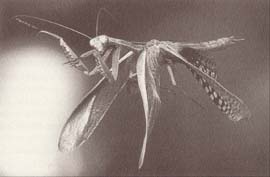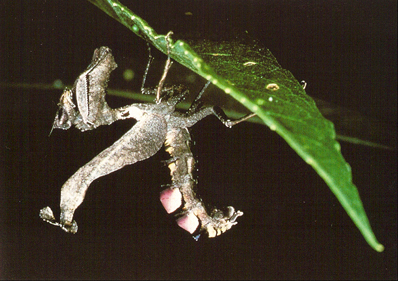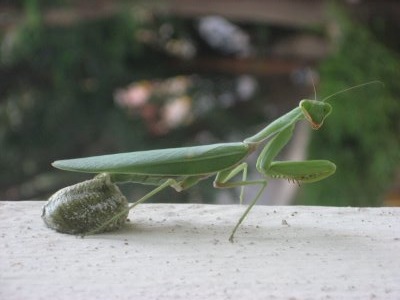Sexual Cannibalism and Mating Behaviors in Mantids
Biology 342 Fall 2010
By: Quinn Langdon and Katherine Thomas
Ontogeny
Onset of Mating Behavior and Sexual Cannibalism
As males are the victims of sexual cannibalism and can only participate in being eaten once, it is a little funny to discuss the development of this behavior in both sexes. Despite the male’s minimal involvement in this endeavor, we'll try to give equal weight to both sexes in our discussion of sexual cannibalism ontogeny. Rates of cannibalism are seen to differ in the life of an individual. During the first one to two weeks after their final molt, the male and female show no interest in one another (Roeder, 1935). Average time of disinterest can vary. Some species, such as Catasigerpes occidentalis, copulates forty-eight hours after moulting, while species such as Hierodula Patellifera (H. Patellifera) copulates approximately two weeks after eclosion.

Picture showing male praying mantis in flight. (Prete 1999)
Role of Pheromones, Female Flexing, and Gamete Maturation
Time until copulation—and potential sexual cannibalism—seems to be related to the amount of time it takes the adult female to begin emitting pheromones and adopt intermittent abdominal flexing behaviors that most likely facilitate pheromone release (Perez, 2005; Robinson and Robinson, 1979). This flexing has been strongly associated with male attraction as males in experimental studies only show interest in flexing females (Prokop and Vaclav, 2005). After behavioral initiation, females exhibit flexing during increasing parts of the day and night until they mate, at which point the behavior and pheromone production is suppressed by an unknown physiological mechanism. Once the behavior is suppressed, the females’ chances of mating and cannibalizing her mate drop drastically until she starts releasing more pheromones after laying at least one oothecae (Lawrence, 1992; Prokop and Vaclav, 2005). Although more research needs to be performed to confirm the genetic basis of pheromone release, it is likely that the genes governing this release also play a role in sexual cannibalism. In at least one species, H. Patellifera, gamete maturation time and time to copulation after eclosion are directly correlated. As such, decreased gamete maturation time may reduce the amount of time between eclosion and the first chance of sexual cannibalism (Prete, 1999; Prokop and Vaclav, 2005).

Picture showing female Acanthops falcata in the pheromone-release posture. (Prete 1999)
Nutritional and Positional Factors
The occurrence of sexual cannibalism seems to be mediated by environmental factors. One of the most important factors affecting cannibalism seems to be nutritional status of the female. In one study, researchers manipulated female nutritional status by feeding females on a high, medium, or low intake diet. Cannibalism was only seen in 20% of the sexual interactions involving females in the high intake condition, 67% of the sexual interactions involving females in the medium intake condition, and 86% of the sexual interactions involving females in the low intake condition (Birkhead et al., 1988). Many researchers feel that the female uses the same mechanism to recognize and attack the male as she does to attack regular prey. In addition, if sexual interactions occur at night, chance of cannibalism is decreased, most likely due to decreased ability of the female to visualize the male’s approach (Polis, 1981).

Picture showing female praying mantis laying oothecae.
Photo citation: http://isharethese.blogspot.com/2009/01/praying-mantis.html
Light and Climate Effects
The climate is seen to affect the timing of praying mantis sexual cannibalism indirectly through affecting the timing of mating. In temperate regions such as Northern California, Portugal, and Maryland, the mantids emerge from their pupal case—eclose— from August to November and thus mating and cannibalism are predominantly seen during this time period (Edmunds, 1975). However, as the latitude gets closer to the equator (in locations such as Trinidad and Western Africa), the time of eclosion is not as defined and mating as well as sexual cannibalism are observed over a larger proportion of the year (Birkhead et al., 1988). Environmental factors can also affect mating in different ways as well, as some species are triggered to mate by changes in light. For example, dark to light alterations that occur at any point during the day cause pheromones to be emitted by Acanthops falcate females and cause spontaneous flight in males of the same species. Such occurrences are consistent with dawn inducing increased mating and hence sexual cannibalism in this and similar species (Lawrence, 1992; Prete, 1999).